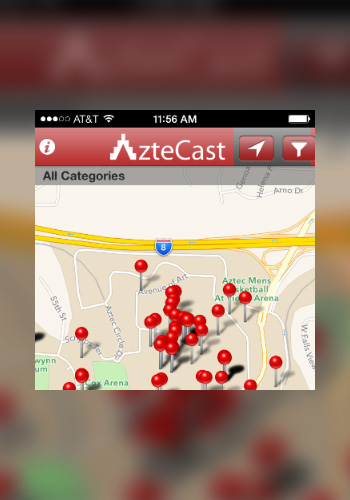Spatial Journalism: A New Frontier

Screen capture of events located at or near SDSU.
February 22, 2017
Dr. Amy Schmitz Weiss obtained funding from SDSU’s highly competitive University Grants Program (UGP) to conduct research on spatial journalism, a practice that is on the forefront of journalistic ingenuity. The grant’s funding will serve as a continuation of the work she initially pursued after becoming a recipient of the Association for Education in Journalism and Mass Communication (AEJMC) Bridge Grant, which was funded by the John S. and James L. Knight Foundation, in 2011.Spatial Journalism Applied
Spatial journalism incorporates space, place and/or location (physical, augmented, and virtual) into the process and practice of journalism. In the spring of 2012, Schmitz Weiss introduced spatial journalism to SDSU with the inception of the AztecCast application for mobile devices. The student-created mobile news application was a joint effort of her journalism class and a computer science class at SDSU. Funded by the AEJMC Bridge Grant, the innovative mobile news app and website provided campus event information based upon the users current location on campus. AzteCast allowed students to have geographically relevant information at their disposal thanks to the use of geo-location technology. “The app (allowed students) to find out about events and information pertinent to any given building (on campus),” said Schmitz Weiss. “If they were in front of the music or science building, for example, they would have access to a list of events and other information on any given day.”Spatial Journalism and Social Media
Through surveys with students and focus groups with the surrounding campus community Schmitz Weiss determined there was interest in expanding the resource. Schmitz Weiss’ research currently focuses on how to better understand the media of physical, augmented, and virtual locations and decipher how each unique entity may develop in the future. The shifting focus from physical location to more abstract forms is a progression that is especially of interest. The UGP funding allows Schmitz Weiss to study how social media and news around the country can integrate and implement spatial journalism and the challenges inherent in doing so. Working with a company in Austin, Texas that is exploring how to incorporate geo-location technology that corresponds with potential legislation on the ballot in the area, Schmitz Weiss has learned first-hand of the power of spatial journalism. “This is the beginning of a new way to reach audiences; thus far, it has proven to be a great way for locals to be intellectually engaged with the happenings of their communities, and that has great benefits for them,” she said.At the Leading Edge
Schmitz Weiss’ research is at the forefront of the development of spatial journalism, and is relevant to local media organizations such as the San Diego Union-Tribune and San Diego’s NBC affiliate, both outlets have shown interest in acquiring geo-location technology. In the sphere of academia, Schmitz Weiss will teach a special topics class on spatial journalism in spring of 2018 for graduate and undergraduate students. Its focus will be on thinking critically and building a skill set while combining journalistic mobile locative media with social network theory. Ultimately, she said, “the goal is to develop a different idea and understanding of a new form of storytelling, but also of journalism and how we as a society consume information.”The content within this article has been edited by Lizbeth Persons.
More PSFA Stories